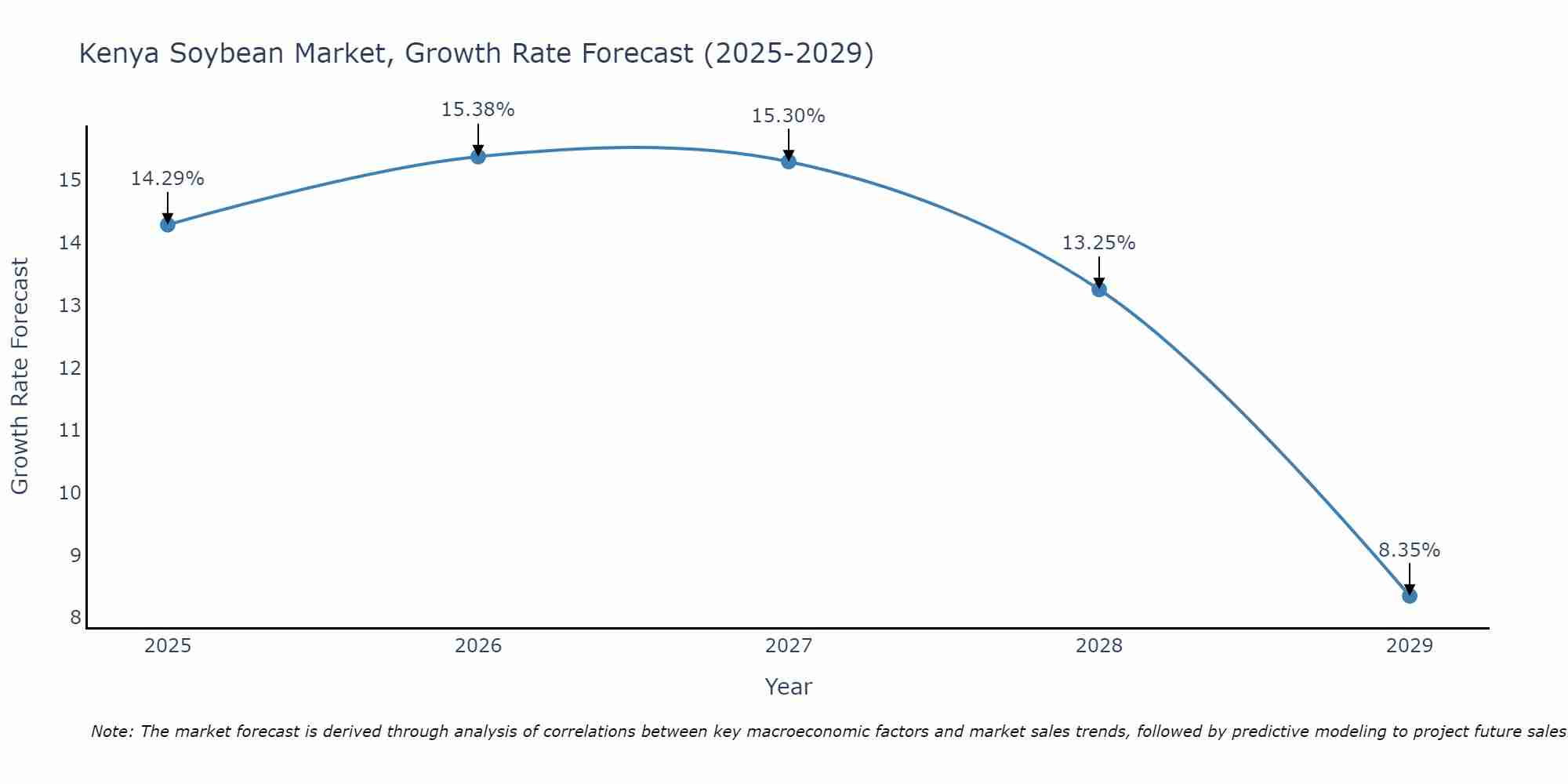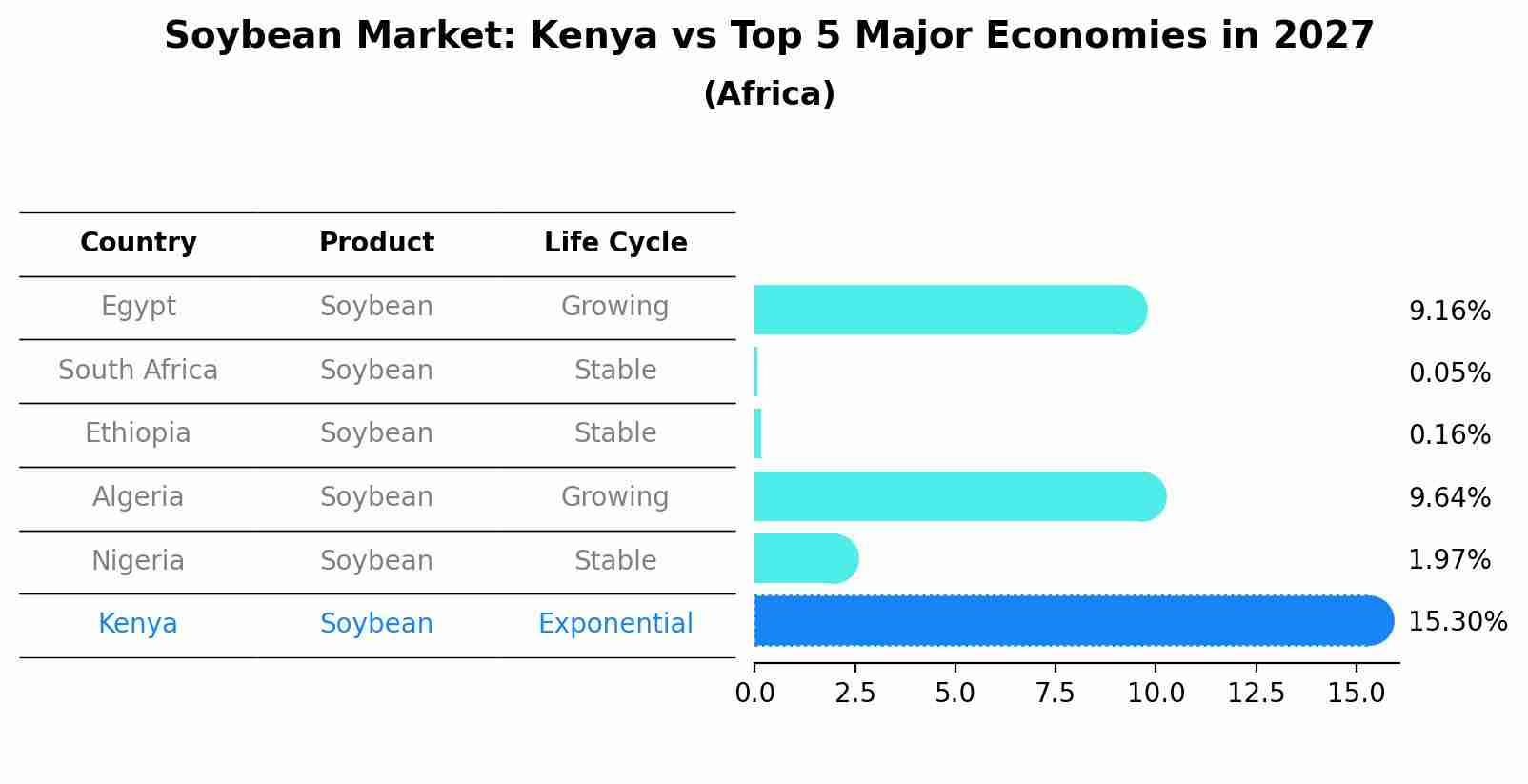Kenya Soybean Market Outlook | Forecast, Size, Analysis, Industry, Share, Companies, Growth, Trends, Value, COVID-19 IMPACT & Revenue
| Product Code: ETC224690 | Publication Date: Aug 2022 | Updated Date: Aug 2025 | Product Type: Market Research Report | |
| Publisher: 6Wresearch | Author: Vasudha | No. of Pages: 75 | No. of Figures: 35 | No. of Tables: 20 |
Kenya Soybean Market Size Growth Rate
The Kenya Soybean Market is projected to witness mixed growth rate patterns during 2025 to 2029. Starting at 14.29% in 2025, the market peaks at 15.38% in 2026, and settles at 8.35% by 2029.

Soybean Market: Kenya vs Top 5 Major Economies in 2027 (Africa)
Kenya's Soybean market is anticipated to experience a exponential growth rate of 15.30% by 2027, reflecting trends observed in the largest economy Egypt, followed by South Africa, Ethiopia, Algeria and Nigeria.

Kenya Soybean Market Overview
The Kenya soybean market is experiencing steady growth driven by increasing demand for soy products in various industries such as food processing, animal feed production, and the pharmaceutical sector. The country`s favorable climate for soybean cultivation, coupled with government initiatives to promote soybean farming, has led to a rise in domestic production. However, Kenya still relies on imports to meet its soybean demand, presenting opportunities for local farmers to increase production and reduce reliance on imports. The market is also witnessing growing interest in sustainable and organic soybean farming practices, reflecting consumer preferences for healthier and environmentally friendly products. Overall, the Kenya soybean market shows promising prospects for further expansion and development in the coming years.
Kenya Soybean Market Trends
The Kenya soybean market is experiencing a growing demand due to the increasing popularity of plant-based proteins. Health-conscious consumers are opting for soy products as a sustainable and nutritious alternative to animal-based proteins. Local farmers are also increasingly turning to soybean cultivation as a profitable cash crop, supported by government initiatives to promote soybean production. Additionally, the expanding food processing industry in Kenya is driving the demand for soybeans as a key ingredient in various food products such as tofu, soy milk, and meat substitutes. As a result, there is a growing emphasis on improving soybean farming practices, increasing yield, and ensuring quality standards to meet the rising market demands and capitalize on the trend towards healthier and more sustainable food choices.
Kenya Soybean Market Challenges
In the Kenya soybean market, several challenges are faced, including limited access to quality inputs such as seeds and fertilizers, inadequate knowledge of modern farming techniques, inconsistent market prices, post-harvest losses due to poor storage facilities, and limited access to credit for smallholder farmers. Additionally, there are issues with pests and diseases affecting soybean crops, lack of proper infrastructure for transportation and storage, and competition from other crops. These challenges hinder the growth of the soybean market in Kenya and make it difficult for farmers to achieve optimal yields and profitability. Addressing these issues through improved access to resources, training programs, market information, and infrastructure development is crucial for the sustainable development of the soybean industry in Kenya.
Kenya Soybean Market Investment Opportunities
The Kenya soybean market presents promising investment opportunities due to increasing demand for soybean products in various industries such as food processing, animal feed, and biodiesel production. With the government`s focus on promoting agricultural productivity and food security, there is a growing emphasis on soybean cultivation as a cash crop for farmers. Investors can explore opportunities in soybean farming, processing facilities, distribution networks, and research and development for improved varieties. Additionally, the potential for export markets further enhances the attractiveness of investing in the Kenya soybean market. However, challenges such as inconsistent production levels, limited processing capacity, and fluctuating international prices should be considered when evaluating investment prospects in this sector.
Kenya Soybean Market Government Policy
The Kenyan government has implemented various policies to support the soybean market, aiming to boost production and enhance food security. Some of these policies include the National Soybean Development Strategy, which focuses on promoting soybean farming through the provision of training, extension services, and access to high-quality seeds. Additionally, the government has established programs such as the National Agriculture and Rural Inclusive Growth Project (NARIGP) to provide financial support and infrastructure development for soybean farmers. Furthermore, the government has imposed import tariffs on soybean products to protect local producers and stimulate domestic production. These policies aim to increase soybean production, improve market access for farmers, and reduce Kenya`s reliance on soybean imports.
Kenya Soybean Market Future Outlook
The future outlook for the Kenya Soybean Market looks promising due to several factors. The growing awareness of the health benefits associated with soy products is driving an increase in demand for soybeans as a source of protein. Additionally, the Kenyan government`s initiatives to promote soybean production through subsidies and support programs for farmers are expected to boost overall production levels. With the rising interest in plant-based diets and the diversification of agricultural practices in Kenya, the soybean market is positioned for growth. However, challenges such as climate change impacts, pest infestations, and competition from other crops may pose hurdles that will need to be carefully managed to ensure the sustained growth of the market.
Key Highlights of the Report:
- Kenya Soybean Market Outlook
- Market Size of Kenya Soybean Market, 2021
- Forecast of Kenya Soybean Market, 2031
- Historical Data and Forecast of Kenya Soybean Revenues & Volume for the Period 2018 - 2031
- Kenya Soybean Market Trend Evolution
- Kenya Soybean Market Drivers and Challenges
- Kenya Soybean Price Trends
- Kenya Soybean Porter's Five Forces
- Kenya Soybean Industry Life Cycle
- Historical Data and Forecast of Kenya Soybean Market Revenues & Volume By Applications for the Period 2018 - 2031
- Historical Data and Forecast of Kenya Soybean Market Revenues & Volume By Crush for the Period 2018 - 2031
- Historical Data and Forecast of Kenya Soybean Market Revenues & Volume By Feed Use for the Period 2018 - 2031
- Historical Data and Forecast of Kenya Soybean Market Revenues & Volume By Food Use for the Period 2018 - 2031
- Kenya Soybean Import Export Trade Statistics
- Market Opportunity Assessment By Applications
- Kenya Soybean Top Companies Market Share
- Kenya Soybean Competitive Benchmarking By Technical and Operational Parameters
- Kenya Soybean Company Profiles
- Kenya Soybean Key Strategic Recommendations
Frequently Asked Questions About the Market Study (FAQs):
1 Executive Summary |
2 Introduction |
2.1 Key Highlights of the Report |
2.2 Report Description |
2.3 Market Scope & Segmentation |
2.4 Research Methodology |
2.5 Assumptions |
3 Kenya Soybean Market Overview |
3.1 Kenya Country Macro Economic Indicators |
3.2 Kenya Soybean Market Revenues & Volume, 2021 & 2031F |
3.3 Kenya Soybean Market - Industry Life Cycle |
3.4 Kenya Soybean Market - Porter's Five Forces |
3.5 Kenya Soybean Market Revenues & Volume Share, By Applications, 2021 & 2031F |
4 Kenya Soybean Market Dynamics |
4.1 Impact Analysis |
4.2 Market Drivers |
4.2.1 Increasing awareness about the health benefits of consuming soybean products. |
4.2.2 Growing demand for plant-based protein sources in Kenya. |
4.2.3 Government initiatives to promote soybean cultivation and processing in the country. |
4.3 Market Restraints |
4.3.1 Limited availability of arable land for soybean cultivation. |
4.3.2 Fluctuating prices of soybeans due to factors like weather conditions and global market trends. |
5 Kenya Soybean Market Trends |
6 Kenya Soybean Market, By Types |
6.1 Kenya Soybean Market, By Applications |
6.1.1 Overview and Analysis |
6.1.2 Kenya Soybean Market Revenues & Volume, By Applications, 2021-2031F |
6.1.3 Kenya Soybean Market Revenues & Volume, By Crush, 2021-2031F |
6.1.4 Kenya Soybean Market Revenues & Volume, By Feed Use, 2021-2031F |
6.1.5 Kenya Soybean Market Revenues & Volume, By Food Use, 2021-2031F |
7 Kenya Soybean Market Import-Export Trade Statistics |
7.1 Kenya Soybean Market Export to Major Countries |
7.2 Kenya Soybean Market Imports from Major Countries |
8 Kenya Soybean Market Key Performance Indicators |
8.1 Percentage increase in the number of soybean processing plants in Kenya. |
8.2 Growth in the adoption of sustainable farming practices among soybean farmers. |
8.3 Improvement in the yield per hectare of soybean crops in Kenya. |
9 Kenya Soybean Market - Opportunity Assessment |
9.1 Kenya Soybean Market Opportunity Assessment, By Applications, 2021 & 2031F |
10 Kenya Soybean Market - Competitive Landscape |
10.1 Kenya Soybean Market Revenue Share, By Companies, 2021 |
10.2 Kenya Soybean Market Competitive Benchmarking, By Operating and Technical Parameters |
11 Company Profiles |
12 Recommendations |
13 Disclaimer |
- Single User License$ 1,995
- Department License$ 2,400
- Site License$ 3,120
- Global License$ 3,795
Search
Thought Leadership and Analyst Meet
Our Clients
Related Reports
- Afghanistan Apparel Market (2026-2032) | Growth, Outlook, Industry, Segmentation, Forecast, Size, Companies, Trends, Value, Share, Analysis & Revenue
- Canada Oil and Gas Market (2026-2032) | Share, Segmentation, Value, Industry, Trends, Forecast, Analysis, Size & Revenue, Growth, Competitive Landscape, Outlook, Companies
- Germany Breakfast Food Market (2026-2032) | Industry, Share, Growth, Size, Companies, Value, Analysis, Revenue, Trends, Forecast & Outlook
- Australia Briquette Market (2025-2031) | Growth, Size, Revenue, Forecast, Analysis, Trends, Value, Share, Industry & Companies
- Vietnam System Integrator Market (2025-2031) | Size, Companies, Analysis, Industry, Value, Forecast, Growth, Trends, Revenue & Share
- ASEAN and Thailand Brain Health Supplements Market (2025-2031) | Strategy, Consumer Insights, Analysis, Investment Trends, Opportunities, Growth, Size, Share, Industry, Revenue, Segments, Value, Segmentation, Supply, Forecast, Restraints, Outlook, Competition, Drivers, Trends, Demand, Pricing Analysis, Competitive, Strategic Insights, Companies, Challenges
- ASEAN Bearings Market (2025-2031) | Strategy, Consumer Insights, Analysis, Investment Trends, Opportunities, Growth, Size, Share, Industry, Revenue, Segments, Value, Segmentation, Supply, Forecast, Restraints, Outlook, Competition, Drivers, Trends, Demand, Pricing Analysis, Competitive, Strategic Insights, Companies, Challenges
- Europe Flooring Market (2025-2031) | Outlook, Share, Industry, Trends, Forecast, Companies, Revenue, Size, Analysis, Growth & Value
- Saudi Arabia Manlift Market (2025-2031) | Outlook, Size, Growth, Trends, Companies, Industry, Revenue, Value, Share, Forecast & Analysis
- Uganda Excavator, Crane, and Wheel Loaders Market (2025-2031) | Strategy, Consumer Insights, Analysis, Investment Trends, Opportunities, Growth, Size, Share, Industry, Revenue, Segments, Value, Segmentation, Supply, Forecast, Restraints, Outlook, Competition, Drivers, Trends, Demand, Pricing Analysis, Competitive, Strategic Insights, Companies, Challenges
Industry Events and Analyst Meet
Whitepaper
- Middle East & Africa Commercial Security Market Click here to view more.
- Middle East & Africa Fire Safety Systems & Equipment Market Click here to view more.
- GCC Drone Market Click here to view more.
- Middle East Lighting Fixture Market Click here to view more.
- GCC Physical & Perimeter Security Market Click here to view more.
6WResearch In News
- Doha a strategic location for EV manufacturing hub: IPA Qatar
- Demand for luxury TVs surging in the GCC, says Samsung
- Empowering Growth: The Thriving Journey of Bangladesh’s Cable Industry
- Demand for luxury TVs surging in the GCC, says Samsung
- Video call with a traditional healer? Once unthinkable, it’s now common in South Africa
- Intelligent Buildings To Smooth GCC’s Path To Net Zero


















